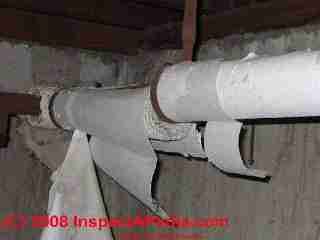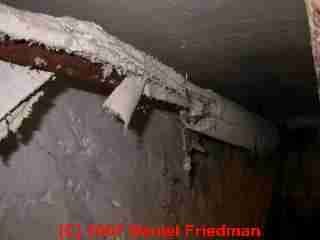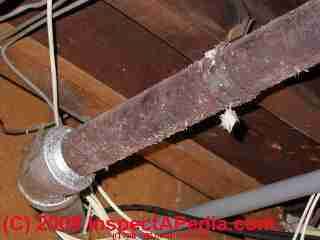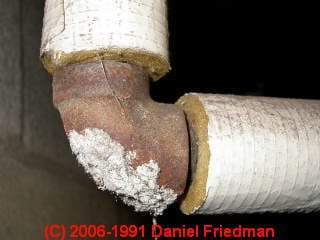 How to spot asbestos in poor condition & what to do about it
How to spot asbestos in poor condition & what to do about it
- POST a QUESTION or COMMENT about how to inspect buildings for damaged or unsafe asbestos based on the condition of the materials
How to identify damaged or unsafe asbestos installations: this article shows how to spot asbestos in poor or damaged condition in buildings & what to do about it, including identification of amateur or improper asbestos "abatement" projects that failed to properly remove materials or that left abandoned asbestos materials in place.
InspectAPedia tolerates no conflicts of interest. We have no relationship with advertisers, products, or services discussed at this website.
- Daniel Friedman, Publisher/Editor/Author - See WHO ARE WE?
ASBESTOS IN POOR CONDITION on heating pipes - How to Recognize

This document assists building buyers, owners or inspectors who need to identify asbestos materials (or probable-asbestos) in buildings by simple visual inspection.
We provide photographs and descriptive text of asbestos insulation and other asbestos-containing products to permit identification of definite, probable, or possible asbestos materials in buildings.
While an expert lab test using polarized light microscopy may be needed to identify the specific type of asbestos fiber, or to identify the presence of asbestos in air or dust samples,
keep in mind that many asbestos-containing building products not only are obvious and easy to recognize, but since there were not other look-alike products that were not asbestos, a visual identification of this material can be virtually a certainty in many cases.
See CEMENT ASBESTOS SHINGLE WEAR SIGNS for indications of worn, friable cement-asbestos products.
For asbestos-containing flooring, see ASBESTOS FLOOR HAZARDS.
Also see ASBESTOS DUCTS, HVAC a field identification guide to visual detection of asbestos in and on heating and cooling system ducts and flue vents.
Also see Micro-Photographs of Dust from the World Trade Center collapse following the 9/11/01 attack. Links to U.S. government and other authoritative research and advice are included.
Asbestos insulation in poor condition like this water pipe asbestos insulation in an 1875 home (falling off, or mechanically damaged) should be removed and properly disposed-of by an asbestos abatement professional.
Incomplete or Amateur Asbestos Removal
Asbestos on heating pipes - highly suspect for contamination

Shown above, fuzzy scraps of asbestos-suspect material left on a rusty steel heating pipe in a basement indicate that
asbestos insulation was removed without cleaning and sealing the surface of the pipe.
Shown below is a close up of asbestos debris left on a heating pipe. The insulation was simply removed without cleaning.
Below we illustrate another heating pipe elbow which was not cleaned of asbestos insulation. Unlike the "corrugated paper" asbestos
insulation used on horizontal pipe runs, an asbestos paste was used at pipe elbows and on other irregular shapes.
 Here is a close up of asbestos insulation paste left on a pipe elbow, evidence of amateur workmanship during
an asbestos insulation remediation.
Here is a close up of asbestos insulation paste left on a pipe elbow, evidence of amateur workmanship during
an asbestos insulation remediation.
The orangish fibrous material under the white covering on the straight pipe runs is fiberglass pipe insulation which has been added.
But the remaining paste on the elbow tells us that the pipes were not cleaned and washed during the remediation.
Someone installed fiberglass heating pipe insulation around the elbow but left the elbow un-cleaned.
The building owner had been told that a proper asbestos removal had been performed and that all pipes were re-insulated.
A professional asbestos abatement company with properly-trained workes and competent supervision would have washed these pipes and probably painted them with a sealant.
Finding scraps of asbestos insulation material left on heating pipes (such as in these photos) is a strong indicator that removal was done by an amateur. In such cases I recommend that the building air and settled dust on surfaces be tested for asbestos contamination since removal was by amateurs.
Any air handling equipment (such as a central air conditioning system) should also be checked for asbestos fiber contamination.
When we see evidence of short cuts and amateur workmanship in an asbestos remediation project we're worried that there may have been asbestos contamination of other site or building areas.
So the expense to "correct" this condition, if testing confirms cross-contamination of the site with asbestos fibers, could be greater than the simple cost to clean and re-insulate the piping. Professional cleaning of other building areas could be needed.
Watch out: in 2010 The New York Times reported [paraphrasing from that article] that over a five year period beginning in 2001 hundreds of asbestos-removal training certificates were given to people who had completed no training whatsoever.
Details are at ASBESTOS REMOVAL, Amateur, Incomplete and ASBESTOS REMOVAL CERTIFICATIONS.
...
Reader Comments, Questions & Answers About The Article Above
Below you will find questions and answers previously posted on this page at its page bottom reader comment box.
Reader Q&A - also see RECOMMENDED ARTICLES & FAQs
On 2019-03-04 by (mod) -
The brown stuff is most likely a mineral fibre - at least with the limits of just eyeballing a photo that's what it looks like to me.
The white paste on the pipe elbows and joints might be an asbestos material - again depending on the age of the installation.
Don't panic - the health effects of panic are probably worse than the material in your photos, especially if it's not disturbed.
What I'd be alert for would be evidence of incomplete prior asbestos removal, indicating an amateur job and thus deserving some followup inspection and testing.
On 2019-02-27 by Anonymous
,thank you for getting g back to me . I’ve been a wreck since I saw this ....sorry to be so incompetent ... I do have another question . Is it the white stuff in the pic that might contain asbestos or the brown stuff that seems to be falling off
On 2019-02-23 by (mod) - Is it dangerous to take this off for testing
I see fiberglass insulation and a lagging plaster thst that could contain asbestos
On 2019-02-23 by Anonymous
Is it dangerous to take this off for testing
IMAGE LOST by older version of Comments code - now fixed. Please re-post the image if you can. Sorry. Mod.
It dosen't seem to have the fluffy look of asbestos so is
Does look like asbestos
Thank you
On 2019-01-09 by (mod) - corrugated asbestos paper type insulation wrapped on pipes.
Your landlord is absolutely mistaken.
The photo plainly shows classic corrugated asbestos paper type insulation wrapped on pipes.
However from just that one ding in the insulation it might be a bit of a stretch to insist that all of the insulation has to be removed.
SOME "consultants" are a bit free to spend other people's money to reduce the consultant's risk (of a complaint that their advice was not sufficiently aggressive or protective). It doesn't cost a consultant one cent to tell you to spend thousands of dollars on something.
I explain the OPM problem at https://inspectapedia.com/home_inspection/Other_Peoples_Money.php
BUT I can NOT second guess your onsite expert further as I cannot see what she or he saw from your one photo.
If in general the material is intact and un-damaged (one ding is not extensive damage) the most-recommended and safest and least costly approach is to encapsulate the material rather than remove it. So encapsulation may be an option.
The treatment of asbestos - remove vs. encapsulate - also depends on the location of the material. Asbestos insulation in a location likely to be impacted or damaged and likely to be tracked into occupied space would be in my view a high priority for attention.
On 2019-01-09 by Amy
Had an environmental consultant advise that the pipes in the basement are covered with asbestos that is degrading and requires professional removal. My landlord says it is not asbestos, but a similar material. What is this on the pipes, please?
IMAGE LOST by older version of Comments code - now fixed. Please re-post the image if you can. Sorry. Mod.
On 2018-09-18 1 by Aaron
I went ahead and sent you a few pics to website email, check them out. Apparently, the sheathing doesn't blatantly contain asbestos, but I had a doc test my response to a sample of it, and there is s omthing in its composition my body doesn't like. Would you recommend cutting the parts that have visible mold out with box cutter, despite the uncertain ingredients?
On 2018-09-15 by (mod) - remove set insulation; some re-insulating alterantives
Thank you for the observations and report, Aaron, and the questions.
IMO you did the right thing to remove wet insulation, as my lab tests have found mold contamination even in previousy-wet fiberglass insulation that to the eye looked clean.
You can re-insulate with any insulation of your choice, though some are easier to install. Open or closed cell foam insulation makes a very tight house but is usually not cost-effective for small or intermittent DIY jobs; rather that works best for a whole house or whole house section insulation project for which you hire a professional.
If there is accessible felt paper housewrap that is moldy and that's accessible, I'd remove it. Since the material is not particularly friable, the potential hazard from an asphalt-impregnated felt paper that contains asbestos, is not likely to be within the limits of detection unless you are grinding or doing some other operation that macerates it.
There are companies marketing mold sprays and killers and sealants. The experts with whom I've studied and consulted all say the same thing:
remove the mold
fix the reasons it occurred
don't panic or you may be fooled into unnecessary and costly procedures or services.
There is no evidence of any asbestos hazard to building occupants from asbestos-containing felt housewrap on the building exterior walls - which is where it'd normally be found: over the sheathing and under the siding.
If there was felt paper on the inner face of outer wall sheathing, such that it's visible in the wall cavity, that'd be quite unusual - I'd want to see photos of that situation in order to have an opinion.
Damp wiping and HEPA vacuuming are standard dust cleanup procedures. Take care not to use the same damp rag to simply spread dust (asbestos- or mold- contaminated) from one area to another by using the same rag continuously.
Tests I did for a government agency found that workers who were "removing mold" by re-using the same damp wipes over multiple objects were simply spreading it more-uniformly across every item. What worked better was to
wipe, fold, wipe, fold, wipe, toss away
About HEPA rated vacuum cleaners, using those is standard advice, though tests by my friend Jeff May in Cambridge found that many of the HEPA-rated models nonetheless leaked so badly that they simply made dust more airborne than ever. A methodical, area-sequenced approach works best.
On 2018-09-15 by Aaron
We had to do some interior paneling demo to access/remove fiberglass insulation which had gotten w
We unknowingly began busting the black stuff out because it had a yellowish surface mold upon it. We were properly suited up with Tyvex suits and full face mask respirators with particulate and vapor filters and gloves for the mold removal, so this likely was helpful for the fiberboard we got into.
The fact is, we have to proceed with other tasks in the house, ( removing Fiberglass batting), but doing such at the safest yet most affordable DIY manner.
Therfore, how do we handle any more remaining sheathing that may have a few small spots of surface mold? ( ie. 4inx4in, not thick, just sparse).
is there a spray coating that you would recommend to encapsulate without disturbing the sheathing))? We think it wisel not to disturb/desroy any more of that black sheathing but, I will still have to remove fiberglass insulation batts from atop of it, to install new insulation back in.
Regarding the insulation reinstall, does using one particular insulation over the other better protect those living in the household from the black asbestos sheathing? ( maybe closed cell foam more airtight? Or maybe I should install rigid xps foam board into the wall stud cavities, or plastic encapsulated fiberglass insulation that is used typically for cathedral ceilings?) Will the well rated $300 Miele HEPA vacuum I have, do well to get rid of the Asbestos particulates that may have settled on the floor?
As well, we do have two powerful fans blowing air outdoors with Negative air pressure/ containment. Answers to these questions, above, and any other tips on how to safely proceed in a DIY manner would be appreciated.
On 2016-10-01 by (mod) - covering for asbestos insulated hot water pipes
There are better products to cover asbestos pipe insulation, thanduct tape, involving less labor and less risk of damaging the material. Fiber lock products, duct wrap products, fabric wraps, paints. Check with your local asbestos abatement pros.
On 2016-10-01 by Anonymous
can i wrap asbestos lined hot water pipes with duct tape to help protect the asbestos
...
Continue reading at ASBESTOS REMOVAL, WETTING GUIDELINES or select a topic from the closely-related articles below, or see the complete ARTICLE INDEX.
Or see these
Recommended Articles
Suggested citation for this web page
ASBESTOS in POOR CONDITION at InspectApedia.com - online encyclopedia of building & environmental inspection, testing, diagnosis, repair, & problem prevention advice.
Or see this
INDEX to RELATED ARTICLES: ARTICLE INDEX to ASBESTOS HAZARDS
Or use the SEARCH BOX found below to Ask a Question or Search InspectApedia
Ask a Question or Search InspectApedia
Try the search box just below, or if you prefer, post a question or comment in the Comments box below and we will respond promptly.
Search the InspectApedia website
Note: appearance of your Comment below may be delayed: if your comment contains an image, photograph, web link, or text that looks to the software as if it might be a web link, your posting will appear after it has been approved by a moderator. Apologies for the delay.
Only one image can be added per comment but you can post as many comments, and therefore images, as you like.
You will not receive a notification when a response to your question has been posted.
Please bookmark this page to make it easy for you to check back for our response.
IF above you see "Comment Form is loading comments..." then COMMENT BOX - countable.ca / bawkbox.com IS NOT WORKING.
In any case you are welcome to send an email directly to us at InspectApedia.com at editor@inspectApedia.com
We'll reply to you directly. Please help us help you by noting, in your email, the URL of the InspectApedia page where you wanted to comment.
Citations & References
In addition to any citations in the article above, a full list is available on request.
- 3/07: thanks to Gary Randolph, Ounce of Prevention Home Inspection, LLC Buffalo, NY, for attentive reading and editing suggestions. Mr. Randolph can be reached in Buffalo, NY, at (716) 636-3865 or email: gary@ouncehome.com
- 06/07: thanks for photographs of transite asbestos heating ducts, courtesy of Thomas Hauswirth, Managing Member of Beacon Fine Home Inspections, LLC and (in 2007) Vice President, Connecticut Association of Home Inspectors Ph. 860-526-3355 Fax 860-526-2942 beaconinspections@sbcglobal.net
- June 1997 - Window Putty - OSHA case cites contractor for asbestos exposure during removal of window putty http://www.osha.gov/pls/oshaweb/owadisp.show_document?p_table=NEWS_RELEASES&p_id=1091
- Asbestos Identification and Testing References
- Asbestos Identification, Walter C.McCrone, McCrone Research Institute, Chicago, IL.1987 ISBN 0-904962-11-3. Dr. McCrone literally "wrote the book" on asbestos identification procedures which formed the basis for current work by asbestos identification laboratories.
- Stanton, .F., et al., National Bureau of Standards Special Publication 506: 143-151
- Pott, F., Staub-Reinhalf Luft 38, 486-490 (1978) cited by McCrone
- ASBESTOS IN YOUR HOME U.S. EPA, Exposure Evaluation Division, Office of Toxic Substances, Office of Pesticides and Toxic Substances, U.S. Environmental Protection Agency, Washington,D.C. 20460
- Asbestos products and their history and use in various building materials such as asphalt and vinyl flooring includes discussion which draws on ASBESTOS, ITS INDUSTRIAL APPLICATIONS, ROSATO 1959, D.V. Rosato, engineering consultant, Newton, MA, Reinhold Publishing, 1959 Library of Congress Catalog Card No.: 59-12535 (out of print, text and images available at InspectAPedia.com).
- "Handling Asbestos-Containing roofing material - an update", Carl Good, NRCA Associate Executive Director, Professional Roofing, February 1992, p. 38-43
- EPA Guidance for Controlling Asbestos-Containing Materials in buildings, NIAST, National Institute on Abatement Sciences & Technology, [republishing EPA public documents] 1985 ed., Exposure Evaluation Division, Office of Toxic Substances, Office of Pesticides and Toxic Substances, U.S. Environmental Protection Agency, Washington,D.C. 20460
- In addition to citations & references found in this article, see the research citations given at the end of the related articles found at our suggested
CONTINUE READING or RECOMMENDED ARTICLES.
- Carson, Dunlop & Associates Ltd., 120 Carlton Street Suite 407, Toronto ON M5A 4K2. Tel: (416) 964-9415 1-800-268-7070 Email: info@carsondunlop.com. Alan Carson is a past president of ASHI, the American Society of Home Inspectors.
Thanks to Alan Carson and Bob Dunlop, for permission for InspectAPedia to use text excerpts from The HOME REFERENCE BOOK - the Encyclopedia of Homes and to use illustrations from The ILLUSTRATED HOME .
Carson Dunlop Associates provides extensive home inspection education and report writing material. In gratitude we provide links to tsome Carson Dunlop Associates products and services.

